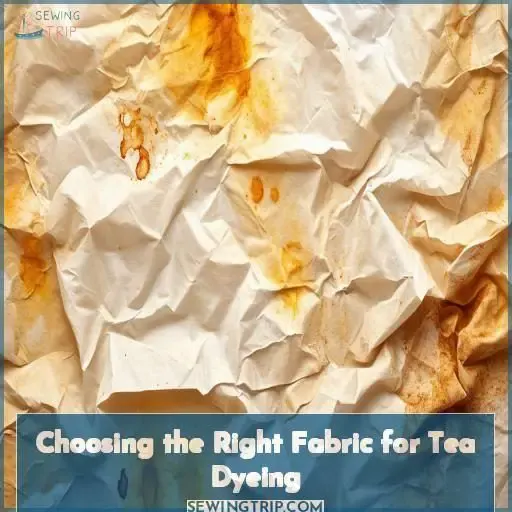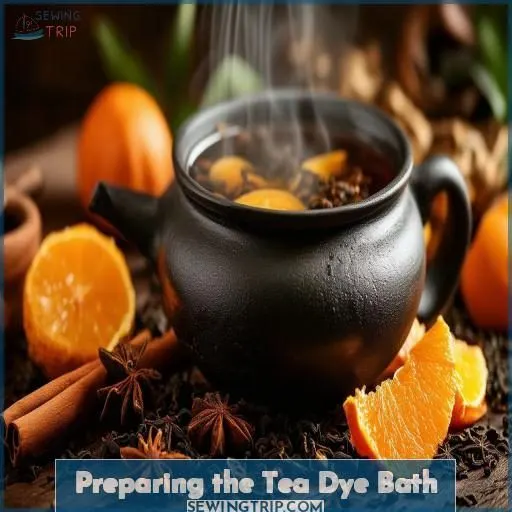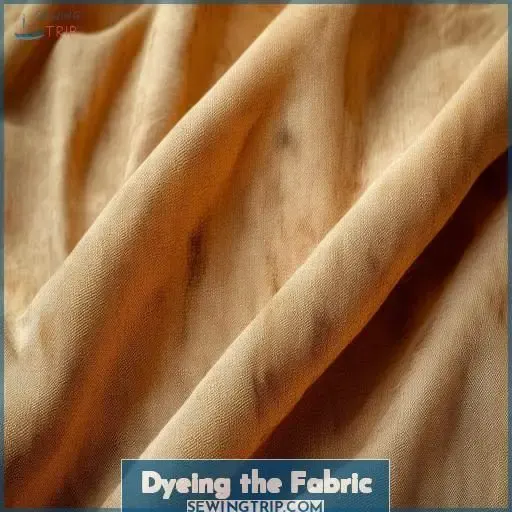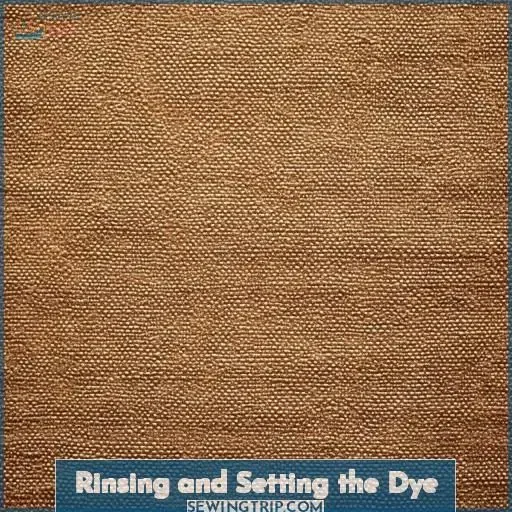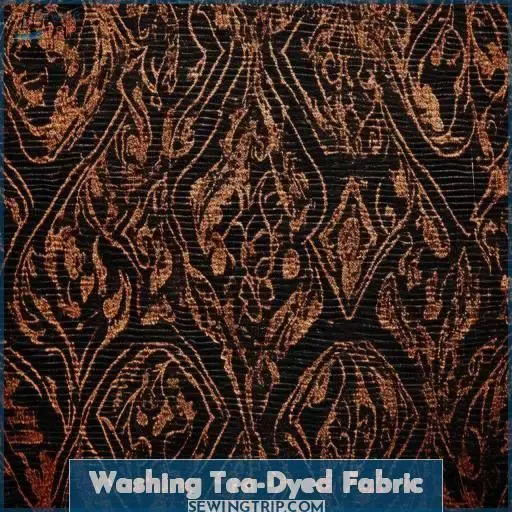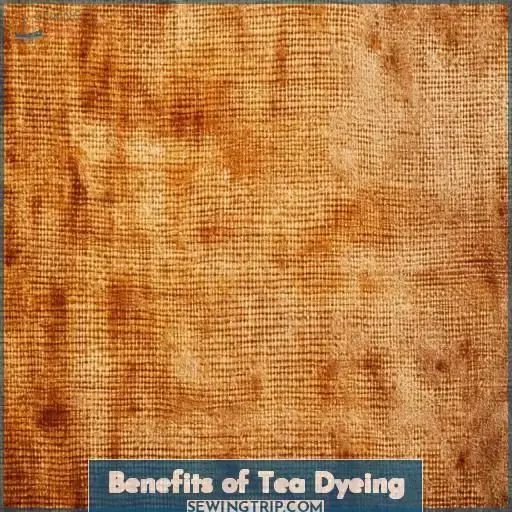This site is supported by our readers. We may earn a commission, at no cost to you, if you purchase through links.
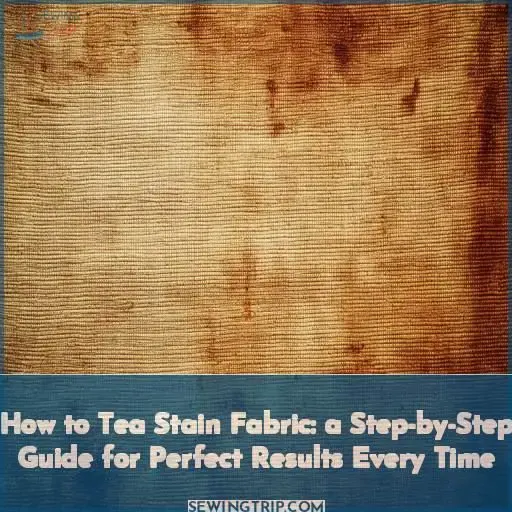 To tea stain fabric, start by selecting natural fibers like cotton or linen and pre-wash to remove any residues.
To tea stain fabric, start by selecting natural fibers like cotton or linen and pre-wash to remove any residues.
Prepare your dye bath by boiling water and steeping tea bags for at least 15 minutes, then add a bit of salt to help set the color.
Submerge your fabric, stirring occasionally for even coverage, and check the color every 15 minutes; for a deeper shade, let it soak overnight.
Once you’ve got the perfect hue, rinse with cold water and set the dye with a vinegar bath.
Air dry your fabric, and you’re done!
Ready to explore more details for perfect results?
Table Of Contents
Key Takeaways
- Tea dyeing is a natural, non-toxic, and inexpensive way to give your fabric a vintage look.
- You can use different types of tea to achieve different colors.
- The longer you soak your fabric in the tea dye, the darker the color will be.
- Tea dyeing is a fun and easy way to add your own personal touch to your clothes and home décor.
How to Tea Stain Fabric?
To tea stain fabric, first choose the right natural fiber, then prepare a tea dye bath by steeping tea bags and adding salt. Submerge the fabric, let it soak to the desired color, then rinse and dry .
Choosing the Right Fabric for Tea Dyeing
Always opt for natural fibers like cotton, linen, silk, or wool when tea dyeing to guarantee the best results. Pre-wash your fabric to remove any residues and consider testing on scrap pieces first to gauge the final color and avoid surprises .
Natural Fibers
Regarding tea dyeing, prioritize using natural fibers over synthetics for optimal results. Consider cotton, linen, wool, or silk. These fibers absorb the dye more evenly and are less challenging to handle. Choose:
- Cotton for versatility.
- Linen for its texture.
- Wool for warmth.
- Silk for a luxurious finish.
Pre-washing Fabric
Pre-washing your fabric is essential, removing coatings or residues that might prevent even dyeing. Wash the fabric with bio soap, then soak it in a water-vinegar solution at a 1:4 ratio to help set the dye. This process also reduces fabric shrinkage and prepares for a more vibrant, mottled effect .
Testing on Scrap Pieces
Before diving into dyeing your primary piece, test your techniques on scrap fabric. Use this smaller canvas to experiment with different tea concentrations and mordants like vinegar. These tests help verify the final color meets your expectations, saving you from surprises and achieving a perfect tea-stained fabric result (Source).
Preparing the Tea Dye Bath
To get started with your tea dye bath, boil a pot of water and steep the tea bags for at least 15 minutes to release the tannins necessary for dyeing. After removing the tea bags, strain the dye, adding salt to help set the color, ensuring your fabric achieves consistent, lasting results.
Steeping Tea Bags
To start preparing your tea dye bath, you’ll need to steep the tea bags in boiling water. Use about 4 cups of water per yard of fabric. Follow these steps:
- Add tea bags to the water for at least 15 minutes.
- Keep the tea temperature consistent.
- Stir occasionally for even tannin release.
Straining the Dye
After the tea has steeped, it’s time for straining the dye to achieve evenness. Use a fine mesh strainer to remove the tea bags, making sure the dye strength is consistent. The method of straining should take into account the tea variety and fabric thickness. Herbal blends can add unique, subtle hues to your tea-stained fabric.
Adding Salt
When preparing the tea dye bath, add 2-4 tablespoons of salt to the simmering water to help set the dye. The salt acts as a mordant, making the color more permanent. Stir thoroughly to dissolve, ensuring an even distribution. This technique enhances the fabric preparation process, leading to uniform, vibrant results .
Dyeing the Fabric
To start dyeing, make sure to fully submerge your pre-washed fabric in the tea dye bath and stir occasionally for even coverage. Check the color every 15 minutes, and for a darker shade, leave the fabric soaking overnight (Source).
Submerging the Fabric
Gently submerge the textile in the prepared tea dye using a wooden spoon to guarantee even penetration of color. Agitate the fabric occasionally to avoid patchiness, and consider layering techniques for varied shades. Utilize squeeze bottles for precise application on linen or muslin. Strain well and hang to dry completely.
Checking Color Regularly
Checking the color regularly guarantees you achieve the perfect shade. Here’s how:
- Submerge Fabric: Fully immerse in the tea bath.
- Stir Occasionally: Use a wooden spoon for even coloring.
- Inspect Every 15 Minutes: Lift a corner to check the shade.
- Adjust Time: Leave for longer if needed, for a richer hue.
This practice optimizes time management and ensures desired dye variations .
Overnight Soaking for Darker Color
To achieve a darker color with tea dyeing, extend dyeing by soaking your fabric overnight in a concentrated tea bath made from black tea or oolong tea. Make sure the fabric is fully submerged, checking occasionally, to guarantee even absorption. This method deepens the hue, creating rich, vintage tones on cotton fabric.
Rinsing and Setting the Dye
To set your tea-dyed fabric, soak it in a vinegar bath for a minimum of 15 minutes to lock in the color. Then, rinse the fabric thoroughly under cold water until the water runs clear before hanging it to dry.
Vinegar Bath
To set your tea-stained fabric, use a vinegar bath. Here’s what you do:
- Mix 1 part white vinegar to 2 parts water.
- Submerge the fabric for 15 minutes.
- Make sure the fabric stays fully immersed.
- Vinegar helps set the dye, reduce odor, and add durability .
Cold Water Rinse
After dyeing, rinse the fabric under cold water to remove excess tea. This step should take about 15 minutes. Use a vinegar solution with a 2:1 water-to-vinegar ratio to set the color. Consider using alternative liquids like green tea for unique effects, or butterfly pea flowers for a swirl pattern.
Hanging to Dry
After thoroughly rinsing your fabric, hang it to dry in a well-ventilated area, away from direct sunlight to prevent fading. The drying time will vary based on fabric thickness. Make certain it’s completely dry to avoid any mildew. This process helps maintain the fabric texture and sets the dye effectively .
Washing Tea-Dyed Fabric
To maintain the rich color of your tea-dyed fabric, always wash it using a cold delicate cycle and bio soap. Be sure to skip the fabric softener, as it can strip away the dye and weaken the quality of the fabric.
Cold Delicate Cycle
Use the cold delicate cycle for washing your tea-dyed fabric. This setting helps prevent fabric shrinkage and maintains color permanence, preserving that charming vintage aesthetic. Delicate cycles guarantee gentle handling, essential for maintaining the integrity of the natural dyeing process with tea. Protect your fabric’s beautiful patina by avoiding harsher settings.
Bio Soap
Using bio soap guarantees eco-friendly, gentle care for your tea-dyed fabric. Opt for a bio soap with no fragrances to keep the process natural. Follow these steps:
- Use a small amount in the washer’s delicate cycle.
- Hand wash if the fabric is delicate.
- Always air dry to maintain the soothing fabric quality.
Avoiding Fabric Softener
After using bio soap, don’t use fabric softener, as it can impact your tea-dyed fabric’s color and texture. Softener coatings might alter the dye’s permanence and vibrancy. Instead, rinse with a vinegar solution to maintain softness and vibrancy.
| Component | Why Use | Alternatives |
|---|---|---|
| Tea Alternatives | Varied color effects | Coffee, herbs |
| Different Fabrics | Unique textures and reactions | Hemp, ramie |
| Salt Substitutes | Mild mordant effect | Baking soda, alum |
| Color Variations | Diverse hues through different teas | Reducing dye time |
| Environmental Impact | No chemical residues | Eco-friendly processes |
Tips for Achieving Desired Results
To achieve the desired results when tea dyeing fabric, use black tea for a darker color and experiment by bundling the fabric for a unique mottled effect. Adjust the dyeing time based on your preference for lighter or darker shades, ensuring the best outcome for your project.
Using Black Tea for Darker Color
To achieve a richer, darker color in your tea-dyed fabric, opt for black tea. Choose high-quality tea bags for the best results. Steep the tea for at least 15 minutes to get a strong concentration.
- Use black tea specifically for its deep pigments.
- Extend steep time for intense color.
- Store black tea dye in a cool, dark place.
Bundling Fabric for Mottled Effect
To create a mottled effect, bundle the wet fabric tightly before submerging it in the tea dye. Use rubber bands or string to secure the fabric bundles. This technique creates unique patterns and blends darker and lighter shades on the fabric surface. Adding salt helps set the dye, enhancing the visual impact .
Adjusting Dye Time for Lighter or Darker Shades
To achieve your desired shade, adjusting dye concentration and soaking time is key. For different effects:
- Adjust dye concentration: More tea bags result in darker hues.
- Experiment with mordants: Vinegar and salt affect color intensity.
- Use various teas: Black tea for dark, green tea for light.
- Soak duration: Longer soaks yield darker fabric results.
Benefits of Tea Dyeing
Tea dyeing fabric offers a natural, non-toxic alternative to synthetic dyes while being remarkably inexpensive and easy to use . You’ll achieve a unique vintage look with permanent color that beautifully enhances various fabrics (Source).
Natural, Inexpensive, Non-toxic
You’ll love how tea stains are natural, inexpensive, and non-toxic, making them perfect for DIY projects! They’re great for anyone passionate about vintage fashion and concerned about the environment. Check out the summary below:
| Natural | Inexpensive | Non-toxic |
|---|---|---|
| Eco-friendly | Cost-effective | Safe for all ages |
| No harsh chemicals | Easy on your wallet | Simple and safe process |
| Sustainable | Budget-friendly | Family-friendly activity |
Vintage Look
Adding tea dye gives your fabric a vintage charm, bestowing it with an antique appeal and an aged effect that’s hard to replicate. This technique brings out a rustic style, imparting a timeless allure that transforms new fabrics into heirloom-worthy pieces with a nostalgic, classic look, enhancing your creative projects beautifully .
Permanent Color
Achieving a permanent color when tea dyeing natural fibers involves using black tea for a darker, vintage look. Combine salt and vinegar to help set the dye, ensuring lasting results. Experiment with bundling fabric for a mottled effect or adjusting dye time if you prefer a lighter shade while maintaining an even tone.
Troubleshooting Common Issues
If your fabric isn’t evenly dyed, it might be due to overcrowding the pot, so make sure to stir regularly to prevent this issue . For those experiencing a too-light color, simply extending the tea bath time can help you achieve a richer hue .
Uneven Dyeing
Troubleshooting uneven dyeing guarantees your tea-stained fabric looks perfect.
- Don’t overcrowd the pot: Dye smaller batches to prevent uneven dye distribution.
- Stir frequently: This avoids color bleeding and patchiness.
- Pre-soak fabric: Ensures uniform absorption.
- Use natural fibers: These preserve texture better and accept dye evenly.
Too Light Color
If your fabric color is too light, consider leaving it in the tea longer or using more tea bags for a richer hue. For uneven dye, make certain the fabric is fully submerged and stirred frequently. Adjust the salt concentration based on fabric type and use a vinegar rinse to help set the color .
Lingering Tea Scent
If your tea-stained fabric has a lingering scent, use baking soda and vinegar to remove it. Follow these steps:
- Soak the fabric in cold water mixed with vinegar (2:1 ratio) for 15 minutes.
- Rinse thoroughly with cool water.
- Wash with a delicate laundry detergent.
- Dry fabric entirely .
Frequently Asked Questions (FAQs)
How long to soak fabric for tea dye?
Soak your fabric in the tea dye for at least an hour, stirring occasionally. For a richer, darker hue, leave it immersed overnight. Regularly check the color to achieve your desired shade .
How to dye fabric with tea or coffee?
To dye fabric with tea or coffee, steep the bags in boiling water, soak your fabric, and submerge for at least an hour. For a deeper shade, let it sit overnight, rinse, and set the color with vinegar .
How do you antique fabric with tea?
To antique fabric with tea, immerse natural fibers in a tea bath prepared with black tea bags, salt, and vinegar. Rinse, dry, and iron for a magnificent vintage appearance that’ll make history blush .
Is tea or coffee better to stain fabric?
Tea provides a softer, subtler stain, ideal for vintage aesthetics and natural tones. Coffee, however, offers a richer, darker tint suitable for bolder, more pronounced effects, making it ideal for projects needing a stronger contrast .
Can tea-stained fabric be dyed again?
You can confidently create beautiful, tailored shades by overdyeing tea-stained fabric. Experiment with various natural dyes to enrich the fabric’s hue and enhance its rustic appeal .
Does tea dyeing affect fabric durability?
Tea dyeing doesn’t [significantly.] affect fabric durability. The natural dye creates a gentle, vintage effect while maintaining the fabric’s integrity. However, repeated dyeing and washing might slightly weaken the fibers over time .
Are there health risks to tea dyeing?
You might worry about safety, but tea dyeing natural fibers is non-toxic, safe, and eco-friendly . Just make certain proper ventilation to avoid any fleeting odors from the process .
How to store leftover tea dye?
Store leftover tea dye in an airtight container in the fridge for up to a week. Use it within this timeframe to maintain its effectiveness for future projects. Make sure the container is tightly sealed to prevent spills.
Will tea dye harm washing machines?
Tea dye won’t harm your washing machine if properly rinsed. Use a delicate cold wash cycle afterward and make certain fabric is rinsed with vinegar, as residual tea can potentially stain machine parts if not managed .
Conclusion
Set out on your tea staining adventure, and you’ll transform bland fabric into a vintage masterpiece! By following this straightforward guide on how to tea stain fabric, you’ve learned to prepare, dye, and set your fabric for a stunning, permanent look.
Experiment with different techniques and enjoy the natural, non-toxic benefits of tea dyeing. With patience and creativity, your projects will boast rich, unique hues, perfect for any DIY endeavor.
Happy dyeing!

